
The Tampa Bay Buccaneers and Seattle Seahawks started their franchises the old fashioned way of having to earn every success they garnered.
Starting in 1976, in an era where free agency did not exist, they had to build a team through tryouts, the regular NFL draft, and the expansion draft. The expansion draft of 1976 consisted of players the other teams planned on cutting anyway. The biggest names were guys considered washed up, while rest were players most people had never heard of.
Seattle did a bit better in the expansion draft, but Tampa Bay did get players like Dave Reavis, Mark Cotney, Louis Carter and Dave Pear who would help the team improve over the next few seasons.
Their first head coach John McKay, a legend at the University of Southern California who is in the College Football Hall of Fame after winning four National Championships, even drafted his own son in that expansion draft.
J.K. McKay lasted three years with them, and currently the Associate Athletic Director at USC under Pat Haden, the man he caught touchdown passes from at USC in the 1970's.
John McKay is said to have regretted leaving USC. His son Rich, currently the president of the Atlanta Falcons and a former Buccaneer general manager, said his dad knew within his first week at Tampa that he made a mistake.
Dick Vermeil called McKay "Dial-a-Quote." One of his most famous quips came a loss that had reporters asking him about the team's play, in particularly their execution. "I'm in favor of it." was his reply.
Though he may have regretted the move, McKay quickly built a winner out of a team that lost their first 26 games. He had them one game away from the Super Bowl in 1979 with a team built on a tough defense and powerful ground game.Tampa Bay was the first post-merger expansion team to win a division title, win a playoff game, and to host and play in a conference championship game.
One obstacle McKay had working against him was an owner reluctant to spend money on the team.
Hugh Culverhouse was set to own the Los Angeles Rams, only to see Robert Irsay buy the team at the last minute. He was then offered the Seattle franchise, but declined because he resided in Florida. Culverhouse then was awarded the Tampa franchise after the man initially planning on buying the team backed out.
While the Buccaneers struggled on the field, Culverhouse was a favorite of the NFL front offices. He helped find a solution in both players' strikes in the 1980's, brought the use of computers into the league, and was heavily involved in NFL finances.
He became the scorn of Buccaneer fans for more than losses. When he raised ticket prices, fans complained to a marketing director on the team who had opposed the hike. Culverhouse made the marketing director the scapegoat, then fired him.
After years of jettisoning good players to save money, or unable to sign top draft picks like Bo Jackson, Culverhouse died in 1994 with questions about the actual financial state of the team that showed it very close to bankruptcy. The Bucs were almost sold to Baltimore Orioles owner Peter Angelos for $200 million with the understanding the team would relocate to Maryland.
It was sold to Malcolm Glazer at the last minute for $8 million less. Under the Glazer regime, the team has won a Super Bowl, and had just six losing seasons. He also got rid of the uniforms colors and logo of the team in 1996, replacing them with the colors and logo you see today.
It has been a fun team for many reasons since entering the league. It boasts one Hall of Famer in defensive end Lee Roy Selmon, but that is expected to change in the coming decade.
This is a team of the best Buccaneers ever to play each position. While a few may end up in Canton soon, they were included here because they are not there yet.
The rest of the squad is full of excellent players who may never find induction into more than their own team's Ring of Honor.
Quarterback : Doug Williams
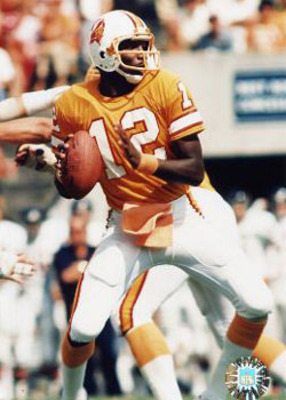
Long before he became known worldwide as the first African-American quarterback to start in and win a Super Bowl, Williams was the Buccaneers first round draft pick in 1978.
He started immediately, yet was brought along very slowly in an offense that relied on running back Ricky Bell's legs.
He threw just five passes in his debut. In the fourth game, he threw for over 300 yards in a season that saw him miss six games because of injuries in between struggles on a team that won five games. He led them to four of the victories.
For a team that started in 1976, then lost their first 26 games, the 1979 season was magical. Tampa Bay won the NFC Central by going 10-6 behind the top rated scoring defense in the league. Though the offense still relied on Bell, who churned out a career best 1,263 yards on the ground, Williams started to develop a repertoire with tight end Jimmie Giles.
The Bucs won their first ever playoff game, beating a favored Philadelphia Eagles that went to the Super Bowl the next year, reaching the NFL Championship's before losing to the Los Angeles Rams.
Williams next three seasons saw his completion percentage and yards passing per game increase each as his sack totals decreased while leading them to the playoffs twice .
After the 1982 season, that was shorted by a players strike, he asked for a pay raise. His wife had just passed away and when his request was spurned, he quickly signed a contract with the Oklahoma Outlaws of the fledgling United States Football League.
He did not play for a year, because the team started in 1984. The Tampa Bay fans were irate at the teams ownership, and the Buccaneers would lose at least 10 games in nine of their next 10 years and not return to the playoffs until 1997.
After two seasons on a struggling team that had moved to Arizona in their second year, he returned to the NFL in 1985 as a member of the Washington Redskins because of his relationship with Joe Gibbs.
Gibbs, a Hall of Fame head coach, was an offensive coordinator in Williams' rookie year. He had a propensity for putting a veteran quarterback on his bench, as he had done with NFL greats like Jim Hart and Steve Bartkowski before.
Williams was supposed to help develop young Jay Schroeder in the 1987 season, but found himself coming off the bench for the injured Schroeder on opening day to lead the team to victory. He had to start the next week for the injured youngster, but Washington lost to the Atlanta Falcons on a late touchdown run by future Redskin Gerald Riggs.
Schroeder started in the third game and got hurt, forcing Williams to come off the bench and lead the team to victory again. Williams did not see action again until the tenth game, when Schroeder was unable to go. The Redskins lost, and it would be until week 15 that Williams would see action again. He came off the pine to help Washington win.
When Washington made the playoffs, Gibbs decided that Williams would start because his 94 rating was better than the 71 Schroeder had. The Redskins would reach Super Bowl XXII, where history would be made in several ways.
The Redskins exploded for five touchdowns in the second quarter against the Denver Broncos, and Williams threw for four scores in that quarter. Both are Super Bowl records that still stand, and he was named MVP of the game.
What made his game so special was the fact that the day before he had undergone root canal surgery under full anesthesia after losing sleep for several days. Though much is made of the fact that his skin color is different than previous Super Bowl-winning quarterbacks, it is more amazing he threw for 340 yards after having dealt with such a health issue.
He started 10 games the next year, but eventually gave way to a young Mark Rypien. When Rypien, a future Super Bowl MVP himself, made the Pro Bowl in 1990, Williams retired.
Though most of his team records in Tampa Bay have now been surpassed, Doug Williams holds more importance to the franchise over maybe any offensive player in team history. He took a team that only knew losing and led them to three playoff appearances in his five seasons.
He did it as both he and the team itself developed, and was a fan favorite of many. He had one of the strongest arms in the league, as one exhibited in the pour rains of Florida one game.
He drifted back to pass on his opponents 25-yard line, but slipped and fell. He sat up and fired a perfect strike to the corner of the end zone for a score while still seated. A move very few players in NFL history could attempt to duplicate.
When one talks of the Buccaneer greatest quarterback ever, it should start and end with Williams.
Brad Johnson, Vinny Testeverde, Trent Dilfer, and Jeff Garcia deserve mention.
Fullback : Mike Alstott

Alstott was drafted by Tampa Bay in the second round of the 1996 draft, and was put in the starting lineup immediately. Though he did not carry the ball much as a rookie, he did catch 65 passes for 557 yards and three touchdowns. All are career high marks for him.
Tampa Bay decided to hand him the ball more often the next year, and he scored ten times while establishing himself as a bruising runner between the tackles. He made the first three consecutive First Team All-Pro nods that year, as well as the first of his six consecutive Pro Bowls.
The 1998 Buccaneers loved to run the ball. Led by Warrick Dunn's 1,026 yards, Alstott chipped in an additional 846 yards and eight scores. They used the formula again the next year, and won their division. Alstott led the team with a career best 949 yards rushing, as the Buccaneers reached the NFC Championship before losing to the Rams, now in Saint Louis, again 11-6 on a late touchdown pass by Kurt Warner.
After missing three games in 2000, he came back to lead the team with 680 yards and a career best ten rushing touchdowns. Tampa Bay then fired Tony Dungy as head coach, replacing him with Jon Gruden.
The move paid off as they won a franchise best 12 games in 2002. They reached Super Bowl XXXVII, where Alstott score the first Super Bowl touchdown in franchise history in their 48-21 win over the Oakland Raiders, the team Gruden had coached the previous season.
After suiting up for just four games in 2003, because of a neck injury, Alstott was never quite the same player again. The last three years of his career was spent mostly as a blocker and occasional short-yardage specialist and receiver.
He retired after the 2006 season. The Buccaneers have since retired his jersey, an honor only shared by Hall of Famer Lee Roy Selmon.
Alstott is still the only offensive player in team history to earn First Team All-Pro honors, and his six Pro Bowls are tied with Selmon as the third most in team history.
He ranks second in team history in rushing and is fourth in receptions, just 16 catches away from second place.
There is also a very good chance Alstott could find himself joining Selmon and inducted into Canton as well.
His versatility and leadership helped the Bucs enjoy the most successful era in their franchise history so far.
William Howard, Ed Williams, and Vince Workman deserve mention.
Halfback : James Wilder
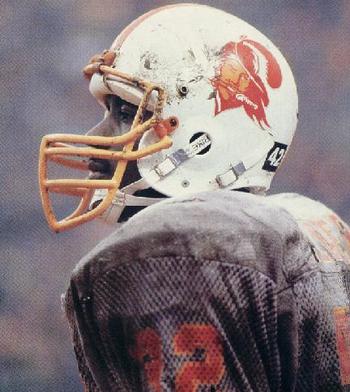
Wilder was the Bucs second round draft pick in 1981 and was moved to fullback for the first three years of his career. After leading the team in rushing and receiving in his second and third seasons, they moved him to halfback.
He led the NFL with 407 carries, a team record, in 1984, gaining 1,544 yards, scoring 13 times, and catching a career best 85 passes. His 2,229 combined yards was second in the league and 15 yards behind Hall of Fame running back Eric Dickerson.
It still is a team record, and it was the sixth best total in NFL history at the time. It still ranks 42nd, and Wilder was named to his only Pro Bowl, the first Buccaneer running back ever to attain this honor, for his efforts.
The following season saw him run for 1,300 yards, catch 53 balls, and score ten times. It would be his last 1,000 yard season, because he gained 704 yards and grabbed 43 passes in 1986 after missing four games because of injury.
Tampa Bay moved him back to fullback in 1987, and he once again led the team in rushing yards and receptions. After missing nine games the next year due to injuries, Wilder was a backup in 1989.
He started the 1990 year with the Washington Redskins, but went unused and was released after one game. The Detroit Lions picked him up, but rarely used him. He retired at the conclusion of the season.
Not only are his two 1,000-yard seasons the highest totals in franchise history, he is the Buccaneers all-time leader in rushing attempts and yards.
His 430 receptions still is a franchise most, over 100 more than wide receiver Mark Carrier in second place.
James Wilder is not only the most productive running back in Buccaneer history, but he is the most versatile. Though he had two exceptional seasons still firmly entrenched in the teams record books, he gave the team nine excellent years where he mostly carried the offense by himself.
Ricky Bell, Warrick Dunn, Jerry Eckwood, Errict Rhett, Reggie Cobb, Michael Pittman, Louis Carter, and Gary Anderson deserve mention.
Wide Receiver : Kevin House
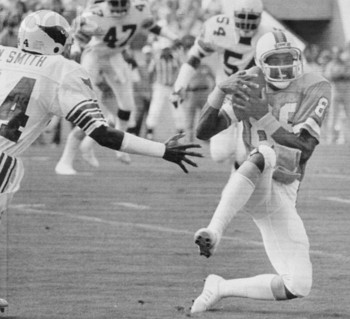
House was drafted in the second round of the 1980 draft by Tampa Bay. He was used as an extra receiver that year, but established himself as a deep threat by averaging 22.1 yards on 24 catches.
He was starting the nest year, and exploded on the NFL by grabbing 56 balls at a 21 yards per catch average. His 1,176 yards and nine touchdowns were career high marks, as was an 84-yard reception that was the longest in team history at the time.
After 28 receptions in the strike-shortened season of 1982, followed by 47 the next year, he had one of his finest seasons in 1984 by catching a career high 76 passes for 1,005 yards. It was a team record at the time, and remained one for wide receivers until Mark Carrier surpassed it in 1989.
After getting 803 yards on 44 catches the next year, House began the 1987 strike-shortened season by averaging 18.7 yards on 11 catches over seven games before he was suddenly released.
The Los Angeles Rams grabbed him off the waiver wire. He spent most of his eight games that year backing up Pro Bowler Henry Ellard and Olympic sprinter Ron Brown, he did start three times and averaged 25.4 yards on seven catches.
After missing four games due to injury in a season he was seldom used, he retired at the conclusion of the 1988 season. When he left the team in 1986,
House was the franchises all-time leader in pass receptions, yards, and touchdowns with 286 for 4,928 and 31 scores when he left the team. He still ranks second in yards and touchdowns, and sixth in receptions. His 84-yard catch is still second longest in team history.
Though his career average of 17.3 yards per catch show House was an effective deep threat, he also had excellent hands and was usually the teams only reliable wide receiver.
He may be the best wide receiver in team history.
Wide Receiver : Mark Carrier
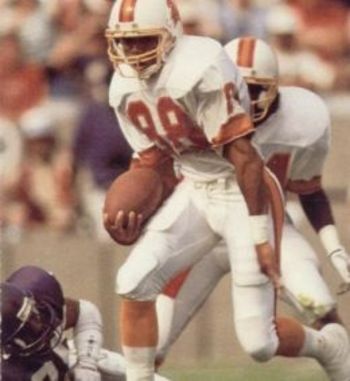
Carrier was drafted by Tampa Bay in the third round of the strike-shortened 1987 season. He worked his way into the starting lineup about halfway into the season, and would remain these most of his Buccaneer career.
After getting 970 yards on 57 receptions in 1988, he had the best year of his career the next season when he became first Buccaneer wide receiver to make the Pro Bowl.
Only two others, Kennan McCardell and Keyshawn Johnson, have attained that honor since then.
He had 86 receptions for 1,422 yards and nine scores. All are career best marks, as was a 78-yard reception.
After 152 receptions and ten touchdowns over the next three years, he joined the Cleveland Browns in 1993. Carrier was used in a variety of ways in Cleveland. He returned a punt for a score, ran for two more, and had eight more on 72 receptions.
He was then drafted by the Carolina Panthers in an expansion draft, where his career was briefly reborn. He led the team with 66 receptions for 1,002 yards in 1995. He also scored three times, one that was the first NFL touchdown in North Carolina.
After 58 receptions the next year, he spent the next two years as a reserve until retiring at the conclusion of the 1998 season.
The 5,018 receiving yards he had in Tampa Bay is the most in franchise history. His 321 receptions is the second most, yet the most ever by a Buccaneer receiver.
He also ranks fourth best in receptions and receiving yards in Panthers franchise history. Carrier was productive and consistent.
Not only was he an excellent route runner, he also was enough of a deep threat to average 15.6 yards per catch. His versatility as a player was underrated.
Keyshawn Johnson, Joey Galloway, Gerald Carter, Mike Carrier, Bruce Hill, Lawrence Dawsey, Keenan McCardell, Isaac Hagins, and Morris Owens deserve mention.
Tight End : Jimmie Giles

Giles was drafted in the third round of the 1977 draft by the Houston Oilers. He spent most of the season backing up Mike Barber, and actually almost doubled him in receptions. The Oilers decided to keep Barber and traded Giles to Tampa Bay.
It was the rookie year of quarterback Doug Williams, but the two quickly developed a repertoire. After making his first Pro Bowl in 1980, from averaging a career high 18.2 yards on 33 receptions, his best season may have been in 1981. He caught 45 balls for 786 yards, both career best marks, while making his second Pro Bowl.
He made the Pro Bowl in the strike shortened season of 1982, then spent the next two years underused and intermittently injured. He then rebounded with his last Pro Bowl year in 1985 after grabbing a career best eight scores on 45 catches.
The 1986 Buccaneers won two games. They had a weak-armed quarterback named Steve Young who has a problem getting the ball deep when he wasn't being sacked 47 times. He would be traded at the end of the year to the San Francisco 49ers, where he enjoyed a Hall of Fame career.
The head coach, Leeman Bennett, was frustrated by an anemic offense that was near the bottom in many categories. The season was already a failure before they played, because first round draft pick Bo Jackson refused to play with them.
Bennett cut Giles and Kevin House, their two best receivers, after the seventh game. His reason was "their collective lack of performance", but some felt it was the owner Culverhouse pinching pennies.
Giles was quickly signed by the Detroit Lions and lasted there until the fourth game of the strike shortened 1987 season. He was released and signed by the Philadelphia Eagles for the final eight games. Giles stayed with the Eagles until the end of 1989, when he retired.
His 34 touchdown catches with the Bucs are the most in team history. The 4,300 receiving yards he accrued are still third most, and easily to most by a tight end, as is his 279 catches, which ranks eight best overall.
Giles was not just a reliable receiver who could catch the ball in crowds over the middle, but he was also an excellent deep threat. He averaged 15.4 yards per catch, which is impressive for a tight end. His 81-yard catch is tied as the second longest in team history.
He was an excellent blocker, but underused as a receiver. If Tampa Bay had thrown him the ball more, he could very well be in the Pro Football Hall of Fame right now.
This was a sentiment echoed by all those who played with and against him. He is not only the first Buccaneer tight end to go to the Pro Bowl, but he is easily the best they ever had wear their jersey.
Jackie Harris, Calvin Magee, Jerry Bell, Dave Moore, Jim Obradovich, Alex Smith, Ken Dilger, and Ron Hall deserve mention.
Tackle : Paul Gruber
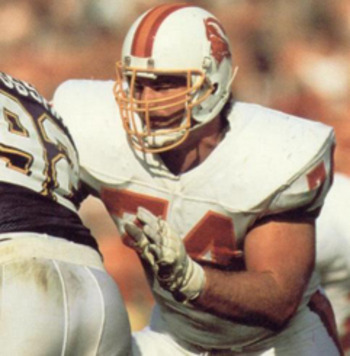
Gruber was the fourth player picked overall in 1988 when the Bucs selected him. They started him at left tackle right away, and he would hold that job the rest of his career.
The 1993 season would see him miss the first games of his career, missing six because of injury, and he missed three more in 1996 for the same reasoning. They would be the only games Gruber would not play in. He also played the first five years of his career without missing a snap.
When he retired after the 1999 season, Gruber had played in 183 games, starting in each game, over 12 years. This was a franchise record until future Hall of Famer Derrick Brooks broke it in 2006. Yet even Brooks never started in each game he played like Gruber did.
Though he was never selected to the Pro Bowl, there were few NFL left tackles in the 1990's more respected than Paul Gruber. He was technically solid, consistent, and reliable.
He is also easily the best offensive tackle in Buccaneers history.
Tackle : Rob Taylor
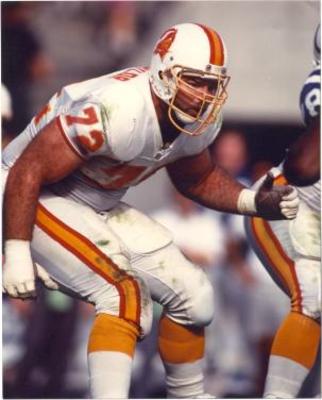
Taylor was drafted in the 12th round of the 1982 draft by the Philadelphia Eagles, but did not make the team. He was out of the NFL for the next four years.
He resurfaced with Tampa Bay in 1986, and made the team. He ended up starting in 13 games as well, and would start in every game he played in over the next four seasons.
After starting in 25 of the next 41 games he played in, Taylor retired at the end of the 1993 season.
He came from virtually nowhere and gave the Bucs 91 starts in 110 games in a career few expected that he would have.
Dave Reavis, Charley Hannah, Gene Sanders, Jerry Wunsch, Scott Dill, Kenyatta Walker, and Ron Heller deserve mention.
Guard : George Yarno
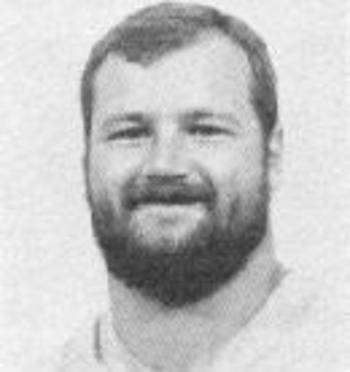
Yarno has this spot until Davin Joseph retires.
He was an undrafted player in 1979 who made the Bucs roster, playing in 15 games as a reserve as a rookie. After starting in 10 games in 1980, he went back to being a valuable reserve and spot starter, starting in eight of the teams next 27 games.
He then started full time the next three years, missing six due to injury. Yarno also converted the only extra point kick of his career in 1983. He also showed his versatility playing both guard spots and even started at left tackle for the 12 games he played in 1985.
He joined the Atlanta Falcons in 1986, starting five games at center, before joining the Houston Oilers the next year and retiring at the conclusion of it.
Yarno was a valuable member of the Buccaneers for eight years, and his ability to play several positions was crucial to the teams successes.
He is currently a respected offensive line coach for the Detroit Lions.
Greg Roberts, Sean Farrell, Arron Sears, and Ray Snell deserve mention.
Guard : Ian Beckles
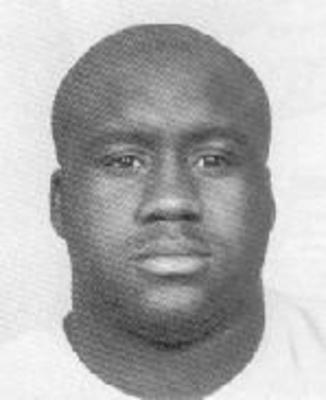
Beckles was drafted in the fifth round of the 1990 draft by Tampa Bay and started immediately, not missing a start for two years.
His remaining time with the team saw him battle nagging injuries. He missed five games in 1993, starting in just seven. He started in every game he played in from then on, but missed five games over the next four years.
Beckles joined the Philadelphia Eagles as a free agent in 1997, but played in just nine games that year. After starting all 16 games the next year, he signed a deal with the New York Jets for the 1999 season.
The Jets head coach criticized Beckles conditioning and cut him. He tried to sign on with the Denver Broncos the next year, but was cut and forced to retire.
Since then, he has been a popular radio host in Tampa Bay.
Tampa Bay does not have a rich history of great guards.
Beckles started in 98 of the 102 games he played with them over seven years, which most likely makes him the best guard who ever played for the franchise over a long period of time.
Center : Tony Mayberry

Mayberry was a fourth round pick by Tampa Bay in 1990, and he spent his rookie year on the bench learning.
He earned the starting job the next year, and would start in 144 consecutive games until he retired after the 1999 season.
The fact is that Mayberry is the most accomplished offensive lineman in team history.
He became the first Buccaneer blocker to make a Pro Bowl in 1997. It was the first of three consecutive appearances.
He is the only Buccaneer offensive lineman with more than one Pro Bowl honor.
Not only is he the greatest center the team has ever had, but he may be their best blocker ever.
Jeff Christy, Steve Wilson, and Randy Grimes deserve mention.
Nose Tackle : Dave Logan
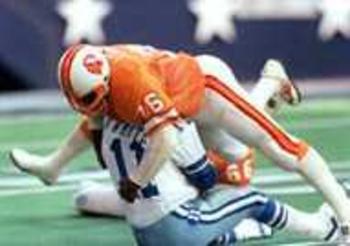
Logan was drafted in the 12th round by Tampa Bay in 1979, and played in five games as a reserve.
He earned the starting job in the third game of the next year, and would hold onto it the rest of his Buccaneers career.
He also scored a touchdown on a career long 60-yard fumble recovery in 1980, and scored again off of a 21-yard return the following season.
In the strike-shortened season of 1982, the NFL began recording sacks as an official statistic, and he was credited with 4.8 sacks in the nine games he played.
His best year may have been in 1983, where he had 9.5 sacks and scored off of a 54-yard fumble recovery. He was named First Team All-Conference by Pro Football Weekly, and would attain that honor again the next year after getting 5.5 sacks and scoring the last touchdown of his career off of a 27-yard interception.
Though he was not named to the Pro Bowl, he was named First Team All-NFL by the Sporting News that year.
After two more years, he left the team and joined the Green Bay Packers in 1987. He played in just two games, got hurt, then retired.
Dave Logan was an incredible physical specimen who relied on intelligence and technique to excel. He weighed just 250 lbs. while playing the most demanding position in football.
He played, and started in, every game in the last six of his eight years with the team. Besides his rookie year, he never missed a game with the Bucs.
He had 39 sacks in his career, which would be the fourth most in franchise history, but the NFL only has him officially with 28.3. That ranks as fifth best, yet it needs to be noted the NFL only recognizes 23 of the 78.5 career sacks Hall of Famer Lee Roy Selmon had with the team.
Logan also had 624 tackles in his career, showing he was more than a pass rusher.
His three fumble recovery touchdowns are the most ever by a Buc defensive lineman, and second in team history to the four defensive back Ronde Barber has. He is tied with 30 other players as the fourth most in NFL history in that category.
He is easily the greatest nose tackle in Buccaneers history.
Dave Pear, the only nose tackle in team history to be named to the Pro Bowl, Brad Culpepper, Anthony McFarland, and Randy Crowder deserve mention.
Defensive End : Warren Sapp
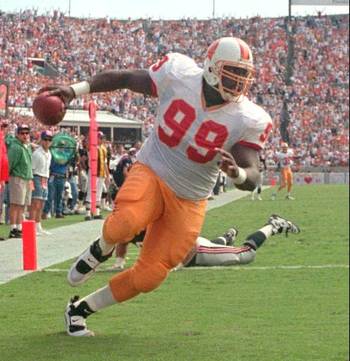
We had to get Sapp on the team, so he goes to defensive end in the 3-4 defense. He won't be here long, because he will be inducted into Canton one day.
He was drafted in the first round by Tampa Bay in 1995, and was brought along slowly as a rookie. He started in eight games, yet scored the only touchdown of his career from a interception return of five yards.
He was named a full-time starter the next year, and would remain so the remainder of his career. He made the first of seven consecutive Pro Bowl appearances in 1997, and was widely known as a productive players who first move was almost as quick as his mouth.
He was named First Team All-Pro in 1999, and would continue to gain that honor until 2002.
His best season came in 2000, where he had a career high 16.5 sacks and 52 tackles. It was just six tackles short of his career best set in 1997.
Sapp became a free agent after his final Pro Bowl season in 2003, and signed a gigantic contract with the Oakland Raiders for seven years. He lasted four in Oakland before retiring at the conclusion of the 2007 season. He played all over the defensive line, getting 19.5 sacks for the Raiders.
Sapp's 77 sacks are the most in Buccaneers history. His six Pro Bowls and four First Team All-Pro nods are the second most in team history. His 96.5 career sacks rank 28th all-time in NFL history, and are the second most ever by a defensive tackle.
Warren Sapp was an excellent pass rusher and a decent run defender. He is the greatest defensive tackle in Buccaneers history. He and Derrick Brooks are the only Buccaneers ever to be named to an NFL All-Decade First Team, which they were for the 2000's decade.
Wally Chambers, John Cannon, Santana Dotson, Chidi Ahanotu, Greg Spires, and Regan Upshaw deserve mention.
Defensive End : Simeon Rice
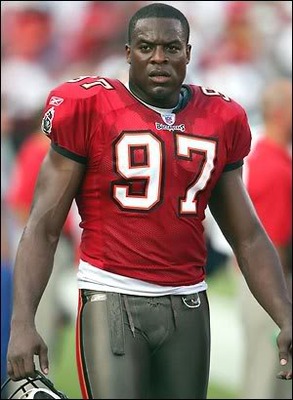
The Arizona Cardinals made Rice the third overall selection in the 1996 draft. He was the Defensive Rookie of the Year and went to one Pro Bowl for the Cardinals over five seasons.
His 51.5 sacks with them is the second most in their franchises history.
Rice signed with Tampa Bay as a free agent in 2001. His best season with them was 2002, where he was named First Team All-Pro and went to the Pro Bowl after Tampa Bay won Super Bowl XXXVII. He was second in MVP voting that game after collecting two sacks.
He also recorded the only safety of his career that season on a stingy defense that allowed just 12.2 points per game, which led the NFL. He made his last Pro Bowl the next year after grabbing a career high two interceptions to go with 15 sacks.
He continued to be a force off the edge until he injured his shoulder in 2006 and missed half the season. Tampa Bay asked him to take a reduction in pay, but Rice refused. They released him, and the Denver Broncos signed him. He lasted six games with them before asking to be released because he was unhappy on how he was being used.
The Indianapolis Colts signed him, but he lasted just two games before they cut him. He got the last sack of his career with them. He tried to revive his career with the New York Sentinels, now know as the Hartford Colonials, of the UFL in 2009, then retired.
The 69.5 sacks Rice accrued over six seasons with the Bucs ranks as the second most in team history. He got to 100 career sacks in just nine seasons, the second fastest to do so in NFL history behind Hall of Famer Reggie White.
His 122 career sacks still ranks 13th best in NFL history.
There have been few players as good as Simeon Rice at rushing the quarterback. He was a valuable member of some excellent Buccaneer teams, and he had a propensity of coming up big when his team needed him most.
He is the second defensive end in Buccaneers history to be an All-Pro and Pro Bowler, and is the second best defensive end the franchise ever had.
Linebacker : Hugh Green

Green was the seventh player chosen overall in the 1981 draft by the Buccaneers after finishing second in the vote for the Heisman Trophy the year before.
He was named a starter immediately, and would remain there his entire time with Tampa Bay. He quickly became known as a big play linebacker who was equally adept in stopping the run as he was rushing the passer.
He made his first Pro Bowl in the strike-shortened 1982 season. The 1983 year was his best. Green made his last Pro Bowl after leading the NFL with two touchdowns off of interceptions.
He was considered one of the best linebackers in the game, then his career was derailed by a car crash in 1984 that ended his season after eight games because of an orbital fracture.
After five games of the 1984 season, Green was traded to the Miami Dolphins and finished the season with a career high 7.5 sacks. His next two years were bereft with nagging injuries, but he came back strong in 1988 to start every games for the next three years. After playing mostly as a reserve in 1991, he retired.
Until Derrick Brooks joined the Buccaneers, Green was considered by many to be the best linebacker to ever play for them. His two Pro Bowls are still the second most ever by an outside linebacker in Buccaneers history. He was very valuable to the team.
His coach, John McKay, was once asked about what weaknesses Green had as a player. All McKay could think of saying was, "He's not twins.''
Linebacker : Hardy Nickerson
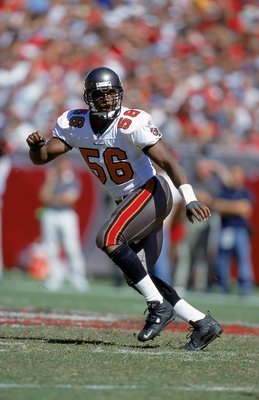
Nickerson was drafted in the fifth round of the 1987 draft by the Pittsburgh Steelers. After spending his rookie year as a reserve, he soon moved into the starting lineup and became a solid member of the team.
He signed with the Buccaneers as a free agent in 1993, and blossomed in the 4-3 base defense that head coach Tony Dungy ran.
He was named First Team All-Pro and to the Pro Bowl in his first season after setting a team record with a whopping 214 tackles that still stands today.
Though he never exceeded 147 tackles in a season for the rest of his career, Nickerson was the fiery, intelligent leader of the defense and was called "The Dragon" by teammates and fans.
In 1996, he went to the Pro Bowl again, something he would continue to do until 1999. He also was named First Team All-Pro in 1997, and was honored with the Byron "Whizzer" White NFL Man of the Year Award for his work in the community and country.
He became a free agent after his last Pro Bowl season of 1999, so he signed a contract with the Jacksonville Jaguars. He got hurt after six games, missing the rest of the season. The 2001 season saw him get a career high three interceptions and nine defended passes. He then signed with the Green Bay Packers in 2002, then retired at the end of the season.
Hardy Nickerson is a member of the NFL 1990's All-Decade Second Team. No other Buccaneers middle linebacker has been to the Pro Bowl, and none have more tackles than him.
"The Dragon" is easily the best middle linebacker in team history.
Dewey Selmon, Richard Wood, Eugene Marve, Jeff Davis, and Scot Brantley deserve mention.
Linebacker : Dave R. Lewis

Lewis was drafted in the second round of the 1977 draft by Tampa Bay. He quickly became a starter and was known for his well rounded game in all facets of his position.
After scoring the only touchdown of his career, which came off a fumble recovery, he became the first linebacker in Buccaneer history to be named to the Pro Bowl in 1980.
Lewis was at the zenith of his game until he was injured in 1981. He was traded to the San Diego Chargers the next year, then was traded to the Los Angeles Rams in 1983. After spending most of the year as a reserve, he retired.
Though his Buccaneers career was cut short, it should not be forgotten. Lewis was solid against the run and pass. He helped the 1979 team lead the NFL in points allowed, with a paltry 14.8 points per game, as they won their first ever divisional title and finished one game away from the Super Bowl.
Cecil Johnson, Broderick Thomas, Winston Moss, Kevin Murphy, and Shelton Quarles deserve mention.
Linebacker : Derrick Brooks
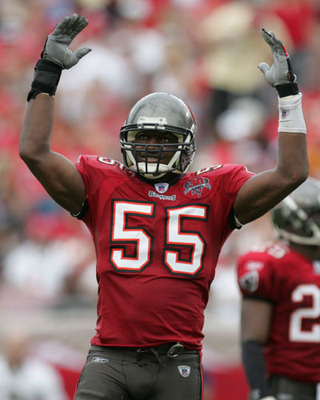
Derrick Brooks was already a legend in the state of Florida before the Bucs used the 28th pick of the 1995 on him. He had grown up in the state, then starred at Florida State University before spending 14 more years starring for Tampa Bay.
He was brought along slowly as a rookie, starting in 13 games. He would never miss a game in his career, and never miss a start from his second season on.
In 1997, he made the first of 10 consecutive Pro Bowl appearances. Though excellent at stopping the run, he was just as exceptional in pass defense. Three times in his career he had 11 passes defended in a season.
He was not just a gridiron star in Florida, but he was a community leader. He shared the 2000 Walter Payton Man of the Year Award with Jim Flanigan Jr. of the Chicago Bears.
The best year he had was the Buccaneers Super Bowl-winning season of 2002. Brooks had a career best five interceptions, and returned three for an NFL-best three touchdowns. One went for 97 yards, the second longest in franchise history.
He also scored on a fumble recovery, making his four touchdowns the most be any defensive player that season. It is the most by a linebacker and the second most by any defender in NFL history.
He was named NFL Defensive Player of the Year, but he was not done. In Super Bowl XXXVII, he picked off a pass and returned it 44 yards for a score.
In 2003, he won both the Byron "Whizzer" White NFL Man of the Year Award and the Bart Starr Man of the Year Award for his community service. He also won the Pro Bowl MVP in 2006 after returning an interception for a touchdown.
Though he failed to make the Pro Bowl in 2007, after having the only season in his career he failed to get a sack, interception, or fumble recovery, he did pile up 109 tackles. The last season of his career was 2008, and he somehow was named to the Pro Bowl despite a career low 73 tackles.
Tampa Bay released him, and he retired in 2010 when he found no suitable offers to play again. No other Buccaneer has made more Pro Bowls or been named First Team All-Pro more than Brooks. He and Warren Sapp are the only Bucs ever to be named to an NFL All-Decade First Team, which they were for the 2000's decade.
His 1,715 tackles are the most in team history, and his 25 interceptions are the most ever by a Buccaneer linebacker.. His six touchdowns for touchdowns, as well as seven total scores, are second in team history to Ronde Barber.
Brooks will own this spot temporarily, because he is destined for the Pro Football Hall of Fame. He is the greatest linebacker in Buccaneers history, and one of their best players ever. He embodies what a Hall of Famer should be on and off the field.
Strong Safety : John Lynch
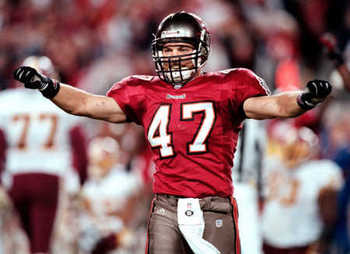
Lynch was drafted in the third round of the 1993 draft by Tampa Bay. He spent his first three years in the NFL primarily as a reserve, starting in 10 of the 40 games he played in.
The 1996 was his first as a starter, and he responded with 103 tackles and three interceptions. He also ran a fake punt for 40 yards. He made the Pro Bowl the next year after getting 109 tackles.
The best season of his career may have come in 1999, where he made his second Pro Bowl and attained his initial First Team All-Pro honor after piling up a career high 127 tackles. He would never get more than 87 tackles in a season for the rest of his career.
Lynch made the Pro Bowl in each of the next four years, and was named First Team All-Pro once more. He was an important member of a Tampa Bay team that won Super Bowl XXXVII in 2002.
After failing to make the Pro Bowl in 2002, Tampa Bay released him. The Denver Broncos signed him and decided to move him to free safety. He lasted four years with the Broncos, getting three interceptions and 271 tackles over that time.
Yet, despite the less than mediocre production, he was named to the Pro Bowl in every season with the team. He missed three games in 2007 and saw he was being phased out. He requested his release, then signed with the New England Patriots. After being cut in training camp, he retired.
His five Pro Bowls are tied as the most ever by a Buccaneers defensive back, and the most by a safety. His two First Team All-Pro nods are the most by any Tampa Bay safety. He ranks fourth in tackles and sixth in interceptions in Buccaneers history after 11 seasons with the team.
John Lynch may only temporarily own this spot, because he has a legitimate chance of being inducted into Canton. Not based on his actual numbers, because there is huge list of safeties waiting for induction who surpass his by quite a bit.
He was extremely popular with the media, then in turn with the fans. This showed by all the Pro Bowls he made despite being outperformed by others at his position many times. The fact that he was on a Super Bowl winning team will help his cause as well.
Regardless, he is the best strong safety the Buccaneers ever had.
Mark Cotney and Marty Carter deserve mention.
Free Safety : Cedric Brown

Brown was drafted in the 12th round of the 1976 draft by the Oakland Raiders, but did not make the team. He was later picked up by Tampa Bay and played in one game that year.
He was named a starter the next year, and would remain one his remaining eight years with the team. He quickly became the glue of the secondary, rarely making errors and generally in the right place at the right time.
He had six interceptions for 110 yards in 1978, both of which led the team. He scored a touchdown on a 80-yard lateral return off a fumble recovery in 1980, thus continuing his reputation as a big play defender in the NFL.
The best season he has was in 1981, getting nine interceptions for 215 yards and two touchdowns. He was somehow not chosen for the Pro Bowl, as Nolan Cromwell, of the Los Angeles Rams, and Dwight Hicks, of the San Francisco 49ers, were instead.
Though he had the same amount of interceptions as Hicks, for just 24 yards less, he easily outperformed Cromwell. Including Brown, six players had nine or more interceptions that year, but only Hicks and Everson Walls went to the Pro Bowl.
After the strike-shortened 1982 season, Brown dealt with injuries. He was able to play in just 17 games over the next two years. He decided to retire after the 1984 season.
The 29 career interceptions he accrued are the most by any safety in Buccaneers history, and it ranks as the third most overall. Though his true impact will never be done justice, because the NFL did not count statistics like tackles, passes defended, and forced fumbles in his era. Cedric Brown's impact can still be seen through other statistics, thus displaying he was one of the most underrated free safeties of his era.
He is in the top-76 in NFL history in fumble return yards in a season, interceptions in a season, interception return yards in a season, and interceptions returned for touchdowns in a season.
He is the best free safety Tampa Bay ever had, one of the very few original Bucs that can claim that at their position.
Curtis Jordan and Harry Hamilton deserve mention.
Cornerback : Donnie Abraham

Abraham was drafted in the third round of the 1996 draft by Tampa Bay. He soon earned a starting job as a rookie, picking off five balls. He duplicated that feat the next season.
The best season of his career came in 1999.He led the NFL with seven interceptions and two interceptions returned for touchdowns. He gained a career high 115 yards off the interceptions, recorded the only two sacks of his career, and had a career best 79 tackles.
He had seven picks the next year, and was named to his only Pro Bowl. He became the second Tampa Bay cornerback to ever be named a Pro Bowler.
After six interceptions in 2001, he signed with the New York Jets as a free agent in 2002. After a productive first year with the Jets, he missed half of the 2003 season because of injury and started in only two games. He contemplated retiring, but decided to not leave the game on that note.
His 2004 season saw him start all 16 games and score a touchdown off both a fumble recovery and interception. Abraham then decided to retire.
His 31 interceptions are the second most in Buccaneers history.
Donnie Abraham may have been the first true lockdown cornerback in team history, and he certainly is one of their best ever.
Cornerback : Ricky Reynolds
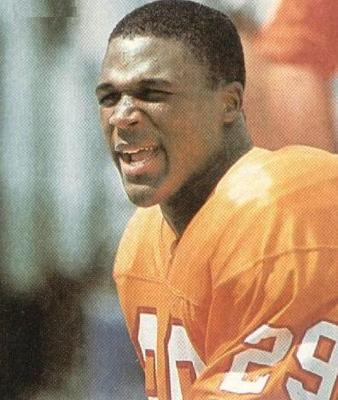
Reynolds was drafted by the Bucs in the second round of the strike-shortened 1987 season. He started right away, and would continue to do so his entire Tampa Bay career.
After four swipes in 1988, he grabbed a career best five interceptions for 87 yards the next year. He also scored on a 68-yard return. He would score again in 1992 off of a fumble recovery.
He signed with the New England Patriots as a free agent in 1994, and scored the last touchdown of his career off of a fumble recovery. After getting a career best 2.5 sacks, along with three interceptions in 1995, he spent parts of the next year hurt and missed four games. He then retired.
Of the 23 career interceptions Reynolds had, 17 came in his seven years in Tampa Bay. Eight of his 12 fumble recoveries came with them too.
He ranks second in franchise history for tackles and fumble recoveries by a cornerback. He still ranks tenth in interceptions, the fifth most by a Bucs cornerback. He was always around the ball. He not only got the ball back a lot for his team, he was in on tackles often.
Ricky Reynolds is easily one of the very best cornerbacks in team history. Ronde Barber will move into this spot when he retires, but Reynolds moves back in if Barber is one day inducted into Canton.
Wayne Haddix, the first Buc to lead the NFL in interceptions and their first Pro Bowl cornerback, Jeris White, Jeremiah Castille, Mark Washington and Brian Kelly deserve mention.
Kicker : Martin Gramatica

Gramatica was drafted in the third round of the 1999 draft by Tampa Bay. He rookie year was solid. He missed just five field goal attempts the entire season.
The 2000 season saw him become the only placekicker in Buccaneers history to be names to the Pro Bowl. He scored 126 points, made five field goals of over 50 yards, and missed just six field goal attempts.
The Bucs won Super Bowl XXXVII in 2002, as he made five more field goal attempts over 50 yards and led the NFL with 32 field goals made. He also scored a career best 128 points, the last time in his career he would score more than 81 points in a season.
Gramatica's accuracy then began to wane. After having never missed an extra point in his career, he missed one in each of his next three years. His field goal accuracy dropped a great deal.
After 11 games in 2004, Tampa Bay cut him. The Indianapolis Colts signed him for four games, where all he did was kickoff.
After sitting out in 2005, he played eight games in 2006 for both the Colts and Dallas Cowboys. He then played eight games over two seasons for the New Orleans Saints.
No Buccaneer has attempted and made more extra points and field goals than Gramatica. His 592 points are also the most in franchise history. His 15 field goals of over 50 yards also is a Buccaneers record.
Besides being the only Pro Bowl kicker Tampa Bay ever had, Martin Gramatica is the best kicker the team ever had.
Michael Husted, Donald Igwebuike, and Matt Bryant deserve mention.
Punter : Mark Royals

Royals spent his rookie season splitting time between the Saint Louis Cardinals and Philadelphia Eagles as an undrafted free agent rookie. He joined the Bucs the next year, staying with them until the end of the 1991 season.
He joined the Pittsburgh Steelers in 1992, and left them for the Detroit Lions in 1995 for two years. Royals then joined the New Orleans Saints in 1997, and led the NFL with a 45.9 yards per punt average that season. After averaging 45.6 the next year, he rejoined Tampa Bay in 1999.
He left for the Miami Dolphins in 2002, then was released after three games in 2003. He then played 11 games for the Jacksonville Jaguars and retired afterward.
Josh Bidwell, the only Pro Bowl punter in Buccaneers history, will get this spot when he retires.
Royals ranks second in Buccaneers history in punt attempts and yards. It also be noted he never had a punt blocked in 414 attempts with the team.
Dave Green, Tom Tupa, and Frank Garcia deserve mention.
Kick Returner : Clifton Smith
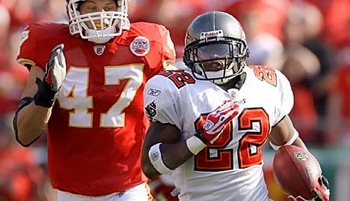
Though Smith is still active, he gets this spot because the well known woes Buccaneer kick returners suffered before his arrival as an undrafted free agent in 2008.
Tampa Bay had went from 1976 to 2007 without once having a player return a kickoff for a touchdown on their behalf until Michael Spurlock broke the 32-year drought.
The proverbial floodgates opened in the ninth week of the 2008 season, his second as a pro, when Smith took one 97 yards for a score, the second in team history.
Two weeks later, he took a punt return 70 yards for another score.
He is the only Buccaneer to ever score off both a kickoff and punt return in the same season.
Despite playing just nine games, he became the first and only Buccaneer return specialist to be named to the Pro Bowl. He had gained a career best 992 yards on a career high 36 kickoff returns, and averaged an excellent 14.1 yards on 23 punt returns.
His 2009 season was cut short by a vicious hit that left Smith with a concussion and the culprit ejected in the 11th game of the season. At the time, he was averaging an impressive 29.1 yards on 31 kickoff returns, and had returned 23 punts for 232 yards.
Called "Peanut" by his teammates, Tampa Bay decided to cut him a week before the beginning of the 2010 season. He signed with the Miami Dolphins, but was cut after hardly playing over two games.
Right now he is the active leader in yards per return average on kickoffs, and he ranks fifth all-time.
He may be Tampa Bay's best kickoff return specialist ever.
Aaron Stecker, Bobby Joe Edmonds, Michael Morton, Donnie Elder, Gary Anderson, Phil Freeman, Torrie Cox, Michael Spurlock, Sammie Stroughter, and Reidel Anthony deserve mention.
Punt Returner : Karl Williams
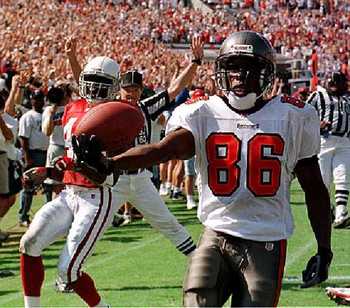
Williams made the Bucs in 1997 as a 25-year-old free agent. He spent the year as an extra receiver but was asked to return just 27 punts and kickoffs. He took one punt for a career long 88-yard score, and Tampa Bay quickly found their punt returner.
He returned a career high 46 punts the next year, at a very impressive 13 yards per return average, while scoring again. He also returned 15 kickoffs and started seven games at wide receiver, setting career high marks of 33 receptions for 486 yards and four scores.
Tampa Bay had him only return 10 punts the next year, while starting six times at receiver. He had nagging injuries that saw him miss three games each year until 2000. Yet the 2000 season was one of his finest as a returner. He returned another punt for a score, and returned a career high 19 kickoffs at a 23.8 yards per return average.
Williams returned a punt for a score every year until 2002, when the Buccaneers won Super Bowl XXXVII.
After just 15 punt returns the next year, he joined the Arizona Cardinals in 2004 and was released at the end of the season.
Nicknamed "The Truth" by his teammates, no Buccaneer has ever returned more punts for more yards and touchdowns than Karl Williams. His five touchdowns off punt returns ranks as 13th best in NFL history, and is the sixth most ever. He also caught 137 passes for seven scores for Tampa Bay.
There has never been a punt returner for the Bucs better than him, and that is the truth.
Danny Reece, Willie Drewrey, Clifton Smith, and Jacquez Green deserve mention.

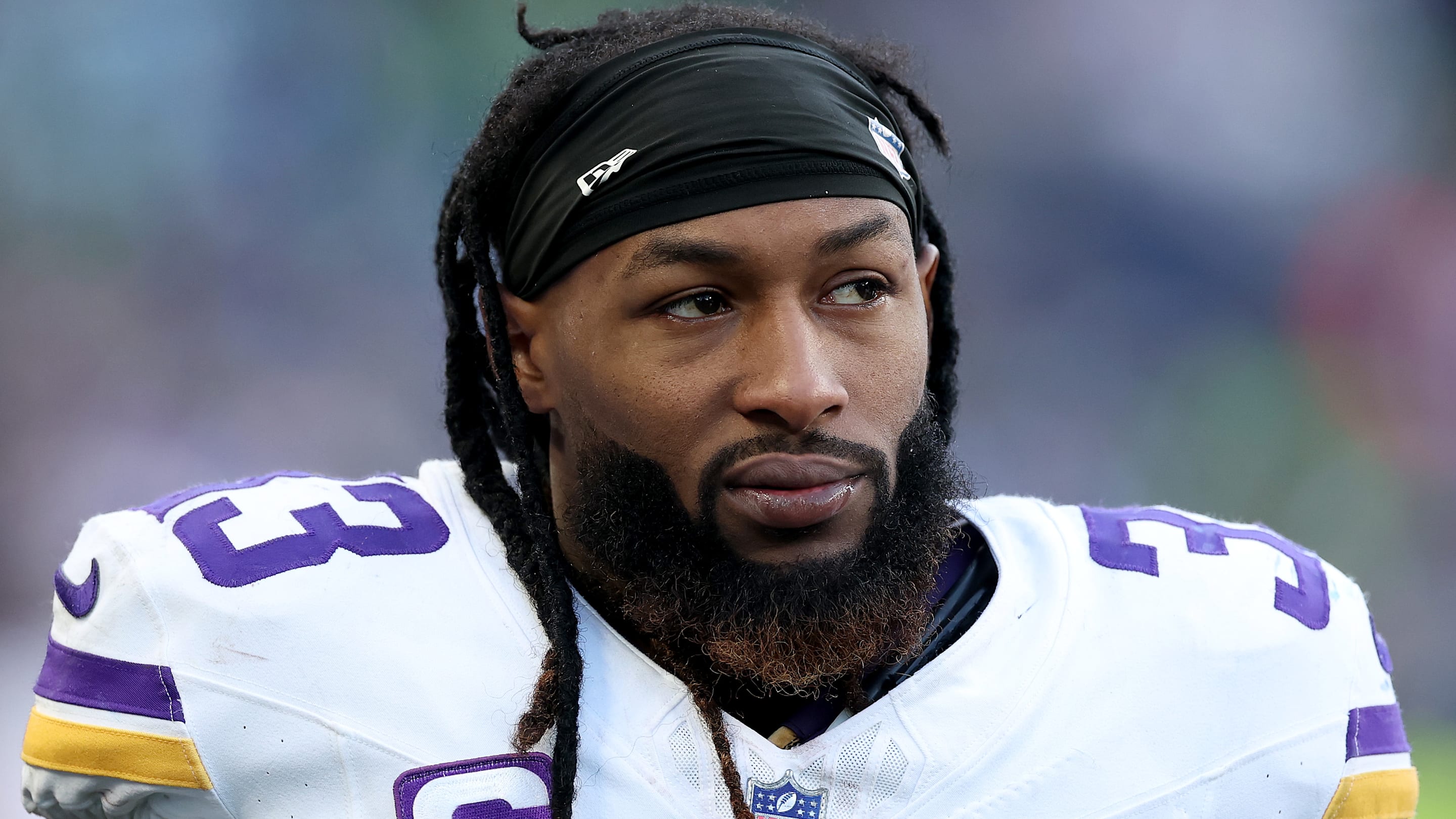
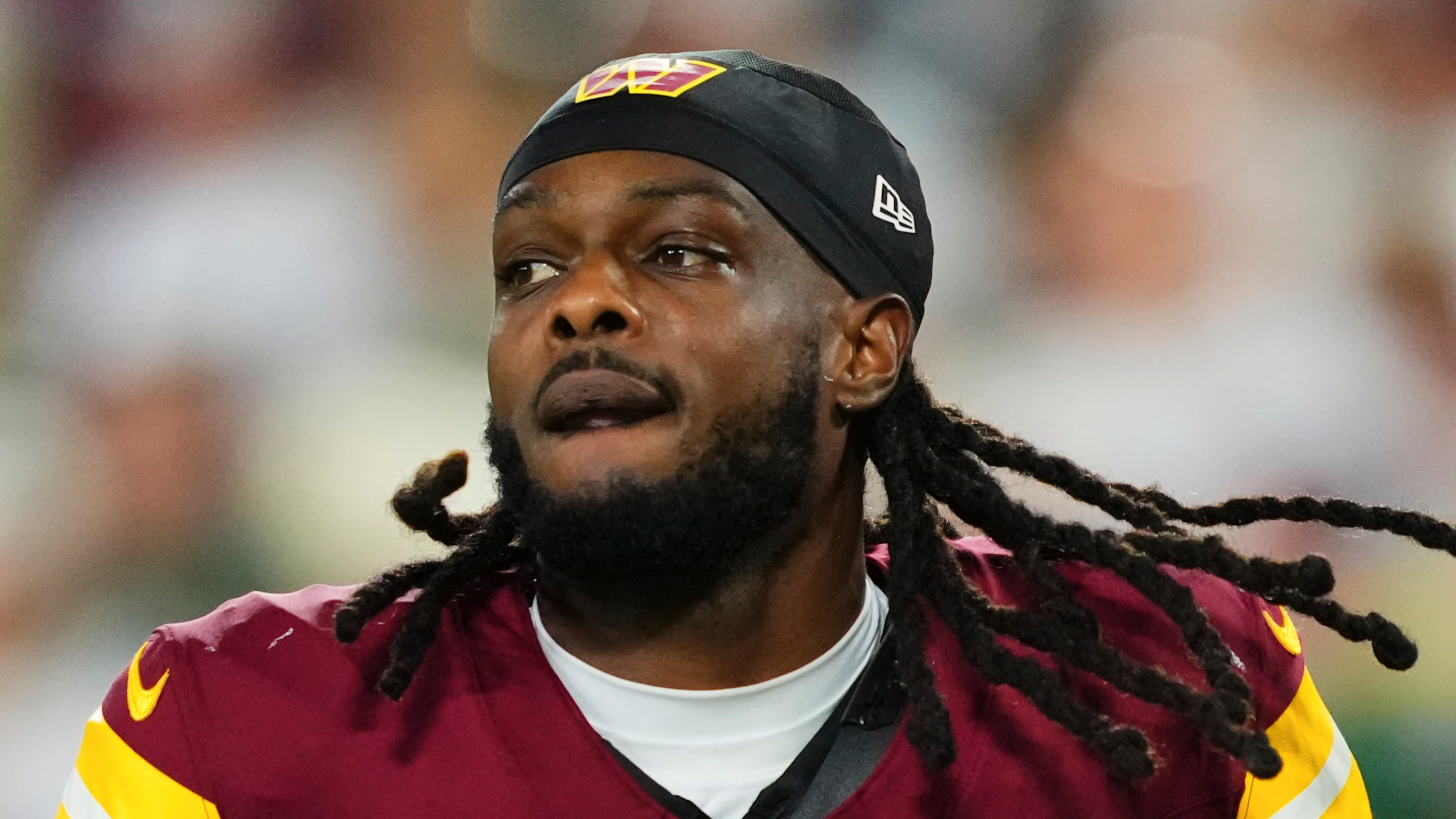




























1 comment:
Dang ... big time work here. Loved watching bruising runner as Alstott. This defense is pretty darn good. If McKay could have only coached this entire group. Well done.
Post a Comment